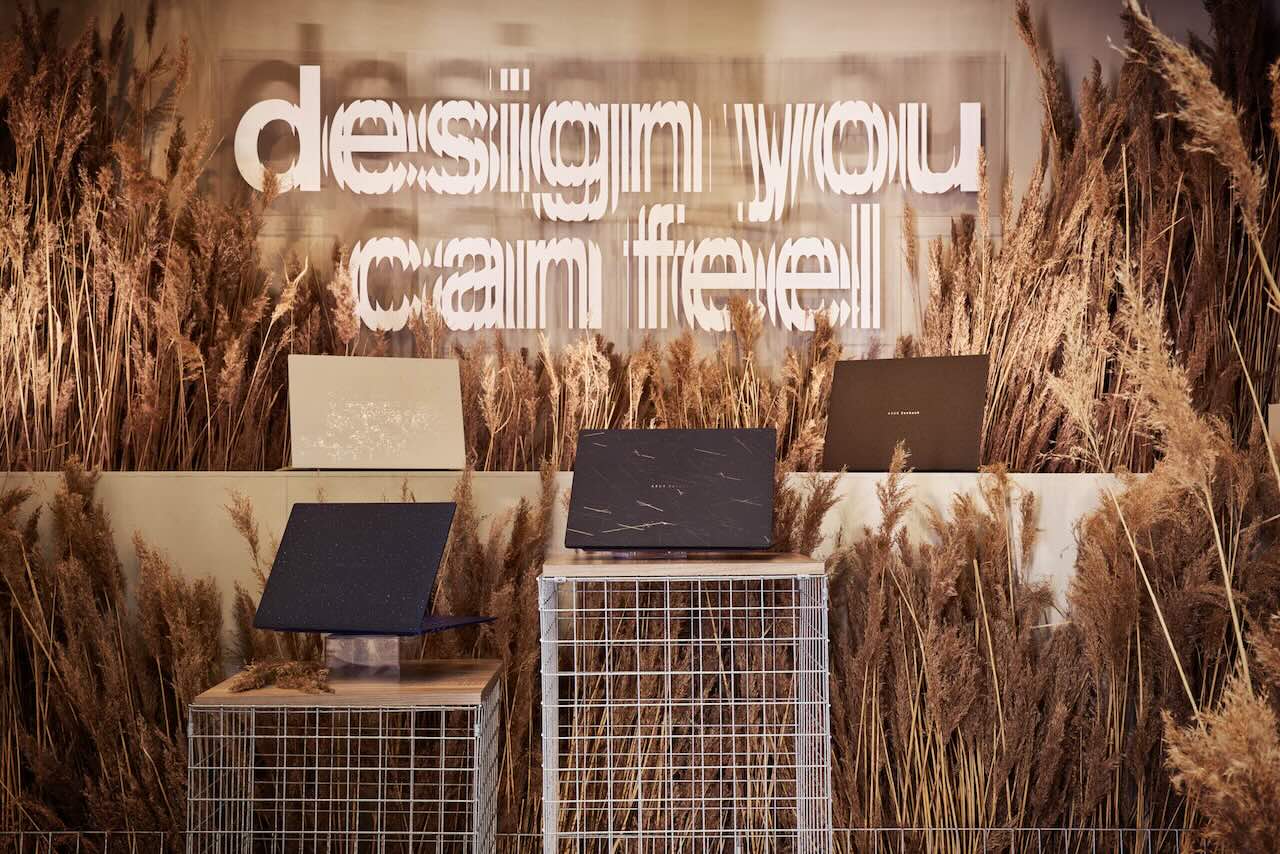
WWW.YANKODESIGN.COM
ASUS Brings Earth, Emotion, and Engineering Together at Milan Design Week 2025
Inside the vaulted Galleria Meravigli, something other than fashion or furniture stole the scene at this year’s Milan Design Week. ASUS arrived not with product displays but with a full-on sensory encounter. The exhibition, titled Design You Can Feel, unfolded across a series of spatial experiences—from sculptural installations to textured laptops that hum with the energy of Icelandic lava and Maldivian surf. This exhibition moved beyond messaging—it was full sensory participation.
Designer: ASUS
Willful Wonder, the centerpiece installation by Studio INI, greeted guests with fluid, wing-like panels that moved in rhythm with each step. Every step triggered movement. Touch fed into sensors, and those signals morphed into reactive, AI-generated visuals that shifted in real time. As visitors moved, the sculpture responded—flexing, folding, revealing, and resetting with each gesture. Material design met behavioral input without screens or instructions.
ASUS built the entire exhibition on three themes: materiality, craftsmanship, and artificial intelligence. These weren’t just taglines; they were baked into the surfaces of every object on display, especially the laptops.
Four Finishes, Four Stories
The Zenbook Ceraluminum Signature Edition series debuted as a tactile tribute to nature’s most evocative terrains. ASUS moved past brushed metal and predictable silhouettes. Each variant in the collection became a study in geological storytelling.
Obsidian Black draws from the volcanic force of Geldingadalir in Iceland. Laser sintering sculpts the surface, mimicking the movement of lava frozen in time. There’s a tangible duality between gloss and matte that feels like magma cooling mid-motion.
Pamukkale White channels Turkey’s cascading terraces. Its soft sheen and gold accents emerge from CNC diamond cutting—light bends and bounces along every curve, like mineral-rich water sliding over travertine steps.
Terra Mocha reaches into Jordan’s Wadi Rum. Its rosette-like geometry emerges not from surface prints, but from within the material, shaped entirely through ASUS’s own ceramization technique. You don’t see the pattern—you sense it, like the grip of sandstone under palm.
Luminous Blue is the most ethereal. Inspired by Vaadhoo Island’s glowing tides, its surface dances under ambient light thanks to calibrated laser-induced oxidation. It shimmers, pulses, disappears in shade, and returns in reflection.
These designs weren’t made for decoration. They were shaped with geological intent, built to retain the memory of the environments that inspired them.
Ceraluminum: Skin and Skeleton
What connects these finishes isn’t aesthetic alone. It’s the material itself—Ceraluminum. ASUS spent four years developing this patented ceramic-aluminum hybrid. No pigments are used, and no acids are involved. The surface is formed by exposing aluminum to precise voltage and mineral inputs through a high-voltage water-based process. That creates a hard, scratch-resistant shell with three times the fracture toughness of anodized aluminum.
It’s not a coating. It is the surface. The hues and porosity are intrinsic, not sprayed on. ASUS refers to this as “modern alchemy.” Fair. It balances mass reduction, structural strength, and textural richness with zero chemical runoff. And it’s 100% recyclable.
The first laptop to feature it fully was the Zenbook A14, already available in Iceland Gray and Zabriskie Beige. At 2.18 pounds and measuring just 0.53 inches at its thinnest, it showed the material’s production potential. The Signature Editions expand that ambition with storytelling built into every curve.
Engineering, Hidden in Plain Sight
Every Signature Zenbook includes top-tier hardware. Intel Core Ultra Series 2 processors and Intel Arc graphics drive the experience. Up to 32GB of LPDDR5X memory and a 1TB PCIe 4.0 SSD handle creative workloads without lag. The vapor chamber cooling system keeps noise low and heat down.
ASUS Lumina OLED displays—3K, 120Hz—show off deep blacks, punchy highlights, and subtle midtones. The sound system is Harman Kardon-certified. There’s a dedicated Copilot key, and the glass touchpad supports smart gestures. No spec is tacked on. Every feature serves a purpose.
The machines feel as refined inside as they do on the outside. Even the sleeves—made from Kvadrat Febrik’s Arda textile—extend the story. Woven from wool using water-efficient methods, they provide grip, protection, and texture.
Not a Concept. Not a Campaign.
Zenbook Signature Editions are real machines built to handle real work. They’re thin enough to slip into a tote, strong enough to live untethered, and precise enough to become part of your everyday rhythm. They aren’t pretending to belong in a gallery. They operate, perform, and happen to also carry the clarity and restraint of something display-worthy.
ASUS hasn’t announced the release date yet, but the Zenbook A14 is already on sale in the U.S. and offers a preview of the Ceraluminum experience in two colorways. For those who value tactility, quiet resilience, and design rooted in place, the Signature Editions mark a new intersection—where Earth meets interface.
Where your next laptop stops feeling like a device and starts behaving like something alive.The post ASUS Brings Earth, Emotion, and Engineering Together at Milan Design Week 2025 first appeared on Yanko Design.
0 Commenti
0 condivisioni
42 Views


